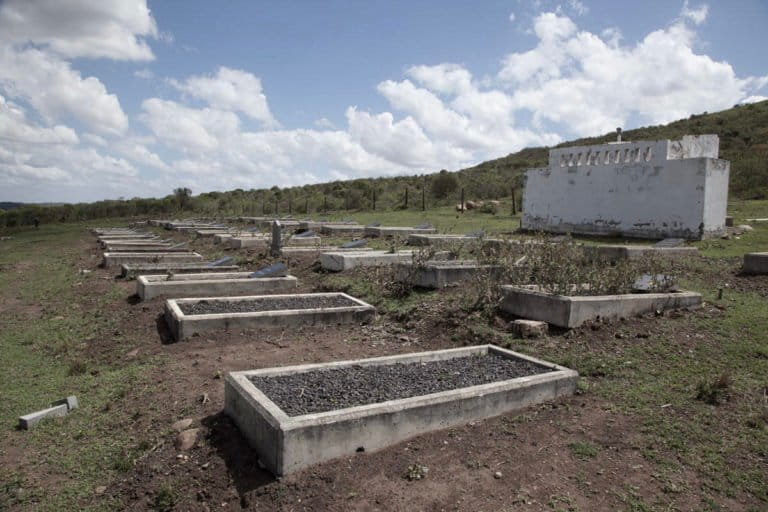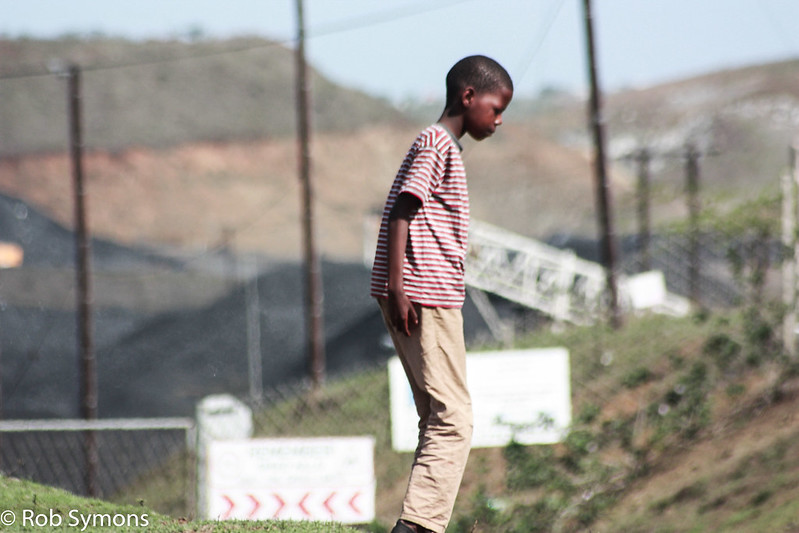- Rural families removed from their homes in Somkhele, in northern KwaZulu-Natal province, to make way for a giant coal mine are suffering from collective trauma, a new report has found.
- A psychologist evaluated members of 26 of the 220 families displaced and found alarming levels of clinical depression and suicidal feelings.
- He found they had been traumatized by witnessing the exhumation of family graveyards as well as the loss of both income and cultural space provided by cattle encosures.
- The report, commissioned by a law firm representing opponents of the mine, recommends that the mine rehabilitate polluted land and water resources and make greater financial compensation available to allow families who wish to leave to reestablish themselves elsewhere.
Residents of a village in northeastern South Africa, displaced to make way for one of the country’s largest open-pit coal mines in 2007, are suffering from long-term collective trauma, with ongoing stressors “having devastating psychosocial impacts” including suicidality and alienation, a clinical psychologist has found.
The residents of the farming village of Somkhele who were displaced lost their homes and farms; and the exhumation and reburial of hundreds of graves was a particularly horrific event, says psychologist Garret Barnwell.
In accordance with Zulu traditions, the affected families had buried their relatives in various places around the homestead, with the head of the family buried next to the isibaya, or cattle enclosure.
“Those buried there have been moved in an undignified way … it was painful to see what was happening. Everyone cried that day, seeing what was happening,” said one resident.
Many people witnessed the partially decomposed bodies of their deceased family members removed from the ground. Some reported seeing diggers plunging pickaxes into the graves and pulling them back out with bones stuck on the picks. A mother whose daughter was exhumed just two months after she was buried, and a man who had buried his wife just three months earlier were just two of many residents who had suffered complicated grief, Barnwell concluded.
The bodies were exhumed from properties marked for demolition; for several families, as many as 30 graves were opened up, said Dineo Skosana, a political scientist at the University of the Witwatersrand’s Society, Work and Politics Institute in Johannesburg, who has researched mining in South Africa extensively.

The remains were then reburied in unmarked graves in a communal area. Speaking at the launch of the report, Skosana said families were unable to identify which of the new graves belonged to whom. She said community members told her that the remains of about 300 people had gone missing entirely during the process of exhumation and reburial.
One elder told her that he often walked around searching for his father’s grave, feeling like he was losing his mind because he could longer visit his gravesite.
The destruction of isibaya that housed cattle, chickens and goats led to more than just a loss of income for the families interviewed. It eliminated an important cultural space for elders to communicate with their ancestors, Barnwell wrote, and prevented young boys from learning the responsibilities, knowledge and masculinities that they customarily gained in these enclosures while being mentored in animal husbandry by their male elders.
Barnwell’s investigation of trauma suffered by residents of Somkhele was commissioned by environmental law firm All Rise, which represents the Mfolozi Community Environmental Justice Organisation (MCEJO) that opposes the mine. All Rise attorney Kirsten Youens said her firm commissioned the report after noticing that many of their clients were despondent.
Thirty-five people from 26 families directly affected by the mine volunteered to take part, most of them residents who identified as MCEJO members. Barnwell found that more than 90% of this group were clinically depressed, and one-third were currently suicidal.
“Our world has changed. It is no longer the same. I feel that things have changed for the worse,” one of the study participants said at an online event marking the publication of the report on Oct. 5. “I have anger every day for the mine … The only thing mining cares about is profit, but they have damaged my soul,”.
Jan du Preez, the chief executive officer of Petmin, the company that owns the mine operator, Tendele, said the mine needed more time to study the report. Du Preez said the report was compiled without any input from Tendele, the Mpukunyoni traditional council, or the 1,600 workers who have been let go following a high court ruling that the mine would not be allowed to expand over another 17 square kilometers (6.6 square miles) in northern KwaZulu-Natal province.
‘The wheels came off’: South Africa court nixes coal mine extension
The court ruled in May that the expansion could not go ahead without conducting a fresh environmental impact assessment and consulting families who stand to lose their land. Du Preez told Mongabay that coal in the existing mine footprint had been exhausted and only a skeleton crew doing care and maintenance remained on site.
“We have also been informed that no one from the Traditional Council or Municipality has been interviewed [for the psychological assessment], and that the study did not for one moment consider the grave implications that the closure of the mine will have on the livelihoods and psychological impact of some 20,000 people in the community that depend on the mine’s survival,” he told Mongabay.
Tensions in the community are high and interviewees spoke anonymously to protect their safety. The traditional authority has supported the mine and the relocation of homesteads, and the mine and local companies providing services have employed thousands of people, though many of these workers are not from Somkhele itself. Families who have held out against the loss of their land have faced sustained harassment.
In October 2020, Fikile Ntshangase, an MCEJO leader, was shot dead inside her home by four assailants who have still not been identified. Barnwell says Ntshangase’s killing and threats to other MCEJO members have contributed to the collective trauma experienced by the community.
The Tendele mine was established in 2007 on land owned communally by thousands of villagers in northern KwaZulu-Natal, next to the Hluhluwe-iMfolozi Game Reserve. After local traditional leaders and the mine struck a deal for compensation, more than 220 families’ homes were demolished and they were relocated.
Before the mine arrived, families had thriving, large homesteads made up of isibaya, vegetable gardens and several buildings each. They had used large tracts of communal land to graze their livestock and forage for fruit, grains, leafy greens, marrows, roots, edible plants, sugarcane, firewood, and cultural and medicinal plants.
Many older residents had joined the Somkhele community during apartheid, after being forcibly removed to create the Hluhluwe nature reserve. “I never wanted to work for a white man,” said one resident, explaining how farming at Somkhele had been a place of pride, independence and security for his family after the earlier forced removal. Today, some residents have had to resort to selling sweets for very little income to survive, interviewees reported.
“There were some challenges before the mine came. The clinic was far from our homes, but life was generally far better than it is now. We were happy with what we had because we had land and food, and we could afford to send our children to school,” said one interviewee.
Another reported that he had cultivated 17 hectares (42 acres) of sugarcane, which he used to support his whole family, pay university fees for children, and set up a retirement fund. The large, fertile communal grazing areas allowed younger adults to work away in cities and supplement their family incomes by keeping livestock at home in the care of elders, an interviewee told Barnwell.
“Somkhele had better living conditions for life. Water was better here where my grandfather had a large area of land and a massive field,” said another participant.
“Psychologically, the mine transgresses the boundaries of the homestead through its creation of dust (as well as other forms of environmental stressors). Produced by the mine, it is seen as an extension of the mine-related collective trauma,” Barnwell wrote.
One resident said the river water is no longer clean because of how close to the mine it flows. Another who lives on the mine’s fence line said, “I stopped planting [food] because all the plants are dying because of the dust.”
Barnwell says that to improve the mental health of the community, the mine would have to cease all pollution, rehabilitate the environment, and provide lifelong psychological care for traumatized community members.
His concluding recommendation calls for reparations that would go beyond compensating families for the loss of their livestock, vegetable gardens and communal grazing land. He says the mine will also need to rehabilitate water sources polluted by mining and pay reparations relating to the unmarked graves and for what he describes as “damages done to the sense of communality and cultural loss.” For traumatized families who want to leave the area, Barnwell says the mine would need to provide enough money for them to buy properties elsewhere.
“Reparations and rehabilitation have been shown to support healing from collective trauma. Critically, reparations must be culturally appropriate, psychologically informed and perceived by the community as meaningful,” Barnwell said.
“We were living very well,” said one of the residents who took part in the psychological assessment. “Now I live in a horrible condition. The mine fenced around the house without consulting us, only [for us] to find that the mine was being built just behind our house. We have been affected by dust and noise day and night. How can anyone just eat dust?”
In South Africa, a community says no after a coal miner said go
Banner image: A boy playing near Tendele’s washing plant: the coal mine has impacted life in the community. Image by Rob Symon via Flickr (CC BY-NC-ND 2.0)
FEEDBACK: Use this form to send a message to the author of this post. If you want to post a public comment, you can do that at the bottom of the page.
